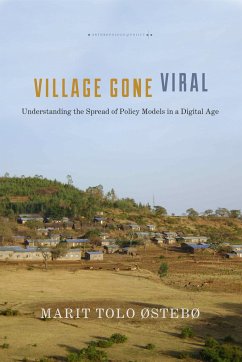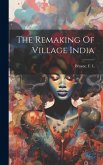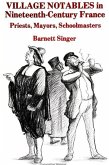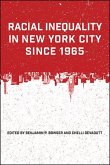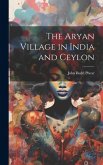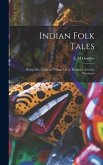- Gebundenes Buch
- Merkliste
- Auf die Merkliste
- Bewerten Bewerten
- Teilen
- Produkt teilen
- Produkterinnerung
- Produkterinnerung
"In 2001, Ethiopian Television aired a documentary about a small, rural village called Awra Amba. It told the story of a self-sustaining and gender-equal community, where women ploughed, men worked in the kitchen, and so-called 'Harmful Traditional Practices' did not exist. The narrative radically challenged prevailing images of Ethiopia as a gender-conservative and aid-dependent place. Soon, Awra Amba became a model for gender equality and sustainable development in Ethiopia and well beyond. Based on ethnographic research in Ethiopia, Europe, the United States, and via the Internet, Marit…mehr
Andere Kunden interessierten sich auch für
![The Remaking Of Village India The Remaking Of Village India]() The Remaking Of Village India38,99 €
The Remaking Of Village India38,99 €![Village Notables in Nineteenth-Century France: Priests, Mayors, Schoolmasters Village Notables in Nineteenth-Century France: Priests, Mayors, Schoolmasters]() Barnett SingerVillage Notables in Nineteenth-Century France: Priests, Mayors, Schoolmasters108,99 €
Barnett SingerVillage Notables in Nineteenth-Century France: Priests, Mayors, Schoolmasters108,99 €![Reclaiming the American Dream Reclaiming the American Dream]() Reclaiming the American Dream202,99 €
Reclaiming the American Dream202,99 €![Archaeological Material From the Village Site at Hot Springs, Port Möller, Alaska Archaeological Material From the Village Site at Hot Springs, Port Möller, Alaska]() Edward Moffat WeyerArchaeological Material From the Village Site at Hot Springs, Port Möller, Alaska33,99 €
Edward Moffat WeyerArchaeological Material From the Village Site at Hot Springs, Port Möller, Alaska33,99 €![Racial Inequality in New York City Since 1965 Racial Inequality in New York City Since 1965]() Racial Inequality in New York City Since 1965112,99 €
Racial Inequality in New York City Since 1965112,99 €![The Aryan Village in India and Ceylon The Aryan Village in India and Ceylon]() John Budd PhearThe Aryan Village in India and Ceylon39,99 €
John Budd PhearThe Aryan Village in India and Ceylon39,99 €![Indian Folk Tales: Being Side-lights on Village Life in Bilaspore, Central Provinces Indian Folk Tales: Being Side-lights on Village Life in Bilaspore, Central Provinces]() Indian Folk Tales: Being Side-lights on Village Life in Bilaspore, Central Provinces35,99 €
Indian Folk Tales: Being Side-lights on Village Life in Bilaspore, Central Provinces35,99 €-
-
-
"In 2001, Ethiopian Television aired a documentary about a small, rural village called Awra Amba. It told the story of a self-sustaining and gender-equal community, where women ploughed, men worked in the kitchen, and so-called 'Harmful Traditional Practices' did not exist. The narrative radically challenged prevailing images of Ethiopia as a gender-conservative and aid-dependent place. Soon, Awra Amba became a model for gender equality and sustainable development in Ethiopia and well beyond. Based on ethnographic research in Ethiopia, Europe, the United States, and via the Internet, Marit [steb² uses the Awra Amba case as a point of departure to examine the widespread circulation and use of models and modeling practices in an increasingly transnational policy world. With a particular focus on traveling models--policy models that become 'viral', that spread widely across different localities through various vectors, ranging from NGOs and multilateral organization to the Internet--this manuscript critically examines how the model paradigm plays out in contexts governed and informed by the politics of metrics and result-driven sustainable development goals. [steb² shows that while a model as a policy or policy tool may appear emancipatory from a global or national perspective, the consequences of being a model may be more ambivalent locally, increasing social inequalities, reinforcing social stratification, and concealing injustice. Village Gone Viral ultimately calls for a reflexive critical anthropology of the production, circulation and use of models as instruments for social change, that explores the power-knowledge effects of models, particularly those that offer themselves as liberatory, at multiple scales and in relation to various actors and media"--
Hinweis: Dieser Artikel kann nur an eine deutsche Lieferadresse ausgeliefert werden.
Hinweis: Dieser Artikel kann nur an eine deutsche Lieferadresse ausgeliefert werden.
Produktdetails
- Produktdetails
- Verlag: Stanford University Press
- Seitenzahl: 248
- Erscheinungstermin: 16. Februar 2021
- Englisch
- Abmessung: 231mm x 150mm x 20mm
- Gewicht: 431g
- ISBN-13: 9781503614512
- ISBN-10: 1503614514
- Artikelnr.: 58664570
- Herstellerkennzeichnung
- Libri GmbH
- Europaallee 1
- 36244 Bad Hersfeld
- gpsr@libri.de
- Verlag: Stanford University Press
- Seitenzahl: 248
- Erscheinungstermin: 16. Februar 2021
- Englisch
- Abmessung: 231mm x 150mm x 20mm
- Gewicht: 431g
- ISBN-13: 9781503614512
- ISBN-10: 1503614514
- Artikelnr.: 58664570
- Herstellerkennzeichnung
- Libri GmbH
- Europaallee 1
- 36244 Bad Hersfeld
- gpsr@libri.de
Marit Tolo Østebø is Assistant Professor of Anthropology at the University of Florida.
Contents and Abstracts
Introduction
chapter abstract
The Introduction opens with a vignette that illustrates the traveling
nature of policy models. This is followed by an outline of the book's
overall argument and objectives and a brief synopsis of how models, in
various forms, increasingly are used as policy instruments and in efforts
aimed at generating social and behavioral change. I then introduce viral
assemblage, a theoretical and analytical concept that can help us make
sense of how ideas and models travel in an increasingly transnational and
digital world. Finally, I move to a methodological section where, in
addition to situating myself in the field, I discuss how the concept of
viral assemblage can also help us make sense of the methods, processes, and
products that we, as anthropologists, engage in and create.
1The Village
chapter abstract
In Chapter 1, I first outline key characteristics of the Awra Amba
community and its history, as commonly conveyed and globally known. I then
transition to an ethnographic vignette that draws on one of my first visits
to the community. In addition to introducing some of the ambivalences,
paradoxes, and silences that spurred me to explore beyond and behind the
official narrative, this account illustrates some of the methodological and
ethical dilemmas I have faced while researching Awra Amba. The chapter ends
with a discussion of these ambiguities.
2Ethiopia-The Real Wakanda?
chapter abstract
In Chapter 2, I situate Awra Amba in a broader historical and political
context. As I detail how development and gender-related policies have
evolved in and been implemented in Ethiopia, I pay particular attention to
the prominent role that models, in various forms, have played in shaping
the political ideologies and policies of the various Ethiopian regimes. The
current government has positioned itself as an independent developmental
state, setting conditions for donor involvement. Nevertheless, I show how
Ethiopia's development policies have been, and continue to be, influenced
by global currents and policies. This is clearly reflected in the way that
gender and women's rights issues are framed in the Ethiopian context.
3The Emergence of a Traveling Model
chapter abstract
By situating Awra Amba within the broader model village paradigm and in
relation to a nearby expert-initiated model village, Chapter 3 deconstructs
the different parts that constitute the Awra Amba model and the various
ways models come into being. I draw on Clifford Geertz's distinction
between models for and models of and Richard Rottenburg's concept of
traveling models to show how multiple models emerge in the Awra Amba case.
I suggest that the power of the traveling model-its capacity to go viral-is
conditioned on the existence of a representative model, which is produced
and performed at a specific place or location and reflects the ideologies
and emotional sentiments of its interacting audience, who picks it up and
facilitates its circulation. In other words, the model for and a
corresponding model of enable and produce the traveling model.
4Alayhim-A Potential Disruption
chapter abstract
With a particular focus on Awra Amba's contested history, Chapter 4 further
explores the dynamics of model making. I argue that model making within the
global policy world, similar to that in fields such as science and
economics, can best be understood as a process of idealization-of ordering
a complex assemblage. This is a process in which actors who benefit from
the model and its status as an ideal type accentuate certain desirable
elements of a perceived reality, while erasing or silencing elements that
create unwanted complexity. In the Awra Amba case, the disruptive elements
are most clearly captured in its partly hidden past-in the community's
historical and ideological links to a Sufi community known as Alayhim. I
end the chapter with an analysis of why Alayhim, just like a virus,
represents a threatening and potentially disruptive element.
5Modes of Transmission
chapter abstract
In Chapter 5, I discuss the vehicles and infrastructure-the multiple
pathways and the networks of actors and vectors-that have facilitated the
spread of the Awra Amba model as a transnational model for gender equality
and sustainable development. To use an epidemiological term, we can think
of this as the traveling model's modes of transmission. While the Awra Amba
case illustrates that the exchange of ideas between conventional policy
actors during policy tours, workshops, and seminars remains important in
terms of facilitating a model's virality, it also points to the importance
of looking beyond conventional policy actors and infrastructure. The
constant emergence of new actors, partnerships, and technologies in our
increasingly globalized and digitalized world has radically changed the
ways policy ideas and models come into being and then travel.
6Going Viral
chapter abstract
Why do some models go viral, while others do not? What is it that has
compelled the various vectors and carriers in the Awra Amba assemblage to
pick up and spread the community's stories and values? These are the
questions I explore in Chapter 6, where I expand current academic
conversations on policy mobility and traveling models, examining stories
told by people who have been "infected" by Awra Amba and as a result are
transmitting and circulating the model. These stories reveal that affect
and desire play a key role in fueling a model's virality. This is an aspect
that the existing literature on policy mobility and traveling models has
overlooked.
7Conditional Virality
chapter abstract
With an empirical focus on Lyfta and the company's flagship product, The
Awra Amba Experience, Chapter 7 sheds light on how emotions and empathy
both fuel and limit Awra Amba's virality. Driven by a passion to foster
global citizenship and empathy and to counter the negative and
stereotypical images that dominate mainstream media, Lyfta's producers very
consciously draw on the logics of affect in the creation and marketing of
their product. Yet, the stories they have produced rely on and reify the
stereotypes they intend to challenge. While it is often assumed that
empathy is key to greater social justice, the commercialization of The Awra
Amba Experience, along with the "othering" that underpins Lyfta's
documentaries, produce exclusionary practices. This shows that empathy not
only is insufficient for understanding power structures but it can also
sustain and create them.
8Being a Model
chapter abstract
How "authentic" are the official Awra Amba narratives? Is Awra Amba a place
where gender equality is real? Chapter 8 sheds light on the effects that
being chosen or identified as a model have on the model itself. I show how
becoming a model has led to increased recognition, benefits, and
preferential treatment for the community, contributing to infrastructural
and economic improvements. Yet, it is also clear that the model status
comes at a price: obligations, responsibilities, and pressures to engage in
representational and performative strategies aimed at maintaining,
controlling, and stabilizing the Awra Amba narrative. The community's
status as a model limits the possibility of questioning and challenging
inequalities and injustices, shaping a community that only partly reflects
the idealized model for a just, gender-equal, and peaceful society depicted
in common representations of Awra Amba.
Conclusion: Infected
chapter abstract
The Conclusion opens with an ethnographic, self-reflective vignette that
describes how I myself, eventually, became "infected" with the Awra Amba
virus. By linking my fascination with Lyfta's products-particularly The
Awra Amba Experience-to a pedagogical model I use in the classroom, I show
how this infection was conditioned on and linked to my own identity and
desires as an educator. Finally, I return to the meta-normative concerns
that animate my work, drawing out the lessons to be learned from this case
study and the relevance of viral assemblage for a context-sensitive,
critical anthropology of traveling models.
Introduction
chapter abstract
The Introduction opens with a vignette that illustrates the traveling
nature of policy models. This is followed by an outline of the book's
overall argument and objectives and a brief synopsis of how models, in
various forms, increasingly are used as policy instruments and in efforts
aimed at generating social and behavioral change. I then introduce viral
assemblage, a theoretical and analytical concept that can help us make
sense of how ideas and models travel in an increasingly transnational and
digital world. Finally, I move to a methodological section where, in
addition to situating myself in the field, I discuss how the concept of
viral assemblage can also help us make sense of the methods, processes, and
products that we, as anthropologists, engage in and create.
1The Village
chapter abstract
In Chapter 1, I first outline key characteristics of the Awra Amba
community and its history, as commonly conveyed and globally known. I then
transition to an ethnographic vignette that draws on one of my first visits
to the community. In addition to introducing some of the ambivalences,
paradoxes, and silences that spurred me to explore beyond and behind the
official narrative, this account illustrates some of the methodological and
ethical dilemmas I have faced while researching Awra Amba. The chapter ends
with a discussion of these ambiguities.
2Ethiopia-The Real Wakanda?
chapter abstract
In Chapter 2, I situate Awra Amba in a broader historical and political
context. As I detail how development and gender-related policies have
evolved in and been implemented in Ethiopia, I pay particular attention to
the prominent role that models, in various forms, have played in shaping
the political ideologies and policies of the various Ethiopian regimes. The
current government has positioned itself as an independent developmental
state, setting conditions for donor involvement. Nevertheless, I show how
Ethiopia's development policies have been, and continue to be, influenced
by global currents and policies. This is clearly reflected in the way that
gender and women's rights issues are framed in the Ethiopian context.
3The Emergence of a Traveling Model
chapter abstract
By situating Awra Amba within the broader model village paradigm and in
relation to a nearby expert-initiated model village, Chapter 3 deconstructs
the different parts that constitute the Awra Amba model and the various
ways models come into being. I draw on Clifford Geertz's distinction
between models for and models of and Richard Rottenburg's concept of
traveling models to show how multiple models emerge in the Awra Amba case.
I suggest that the power of the traveling model-its capacity to go viral-is
conditioned on the existence of a representative model, which is produced
and performed at a specific place or location and reflects the ideologies
and emotional sentiments of its interacting audience, who picks it up and
facilitates its circulation. In other words, the model for and a
corresponding model of enable and produce the traveling model.
4Alayhim-A Potential Disruption
chapter abstract
With a particular focus on Awra Amba's contested history, Chapter 4 further
explores the dynamics of model making. I argue that model making within the
global policy world, similar to that in fields such as science and
economics, can best be understood as a process of idealization-of ordering
a complex assemblage. This is a process in which actors who benefit from
the model and its status as an ideal type accentuate certain desirable
elements of a perceived reality, while erasing or silencing elements that
create unwanted complexity. In the Awra Amba case, the disruptive elements
are most clearly captured in its partly hidden past-in the community's
historical and ideological links to a Sufi community known as Alayhim. I
end the chapter with an analysis of why Alayhim, just like a virus,
represents a threatening and potentially disruptive element.
5Modes of Transmission
chapter abstract
In Chapter 5, I discuss the vehicles and infrastructure-the multiple
pathways and the networks of actors and vectors-that have facilitated the
spread of the Awra Amba model as a transnational model for gender equality
and sustainable development. To use an epidemiological term, we can think
of this as the traveling model's modes of transmission. While the Awra Amba
case illustrates that the exchange of ideas between conventional policy
actors during policy tours, workshops, and seminars remains important in
terms of facilitating a model's virality, it also points to the importance
of looking beyond conventional policy actors and infrastructure. The
constant emergence of new actors, partnerships, and technologies in our
increasingly globalized and digitalized world has radically changed the
ways policy ideas and models come into being and then travel.
6Going Viral
chapter abstract
Why do some models go viral, while others do not? What is it that has
compelled the various vectors and carriers in the Awra Amba assemblage to
pick up and spread the community's stories and values? These are the
questions I explore in Chapter 6, where I expand current academic
conversations on policy mobility and traveling models, examining stories
told by people who have been "infected" by Awra Amba and as a result are
transmitting and circulating the model. These stories reveal that affect
and desire play a key role in fueling a model's virality. This is an aspect
that the existing literature on policy mobility and traveling models has
overlooked.
7Conditional Virality
chapter abstract
With an empirical focus on Lyfta and the company's flagship product, The
Awra Amba Experience, Chapter 7 sheds light on how emotions and empathy
both fuel and limit Awra Amba's virality. Driven by a passion to foster
global citizenship and empathy and to counter the negative and
stereotypical images that dominate mainstream media, Lyfta's producers very
consciously draw on the logics of affect in the creation and marketing of
their product. Yet, the stories they have produced rely on and reify the
stereotypes they intend to challenge. While it is often assumed that
empathy is key to greater social justice, the commercialization of The Awra
Amba Experience, along with the "othering" that underpins Lyfta's
documentaries, produce exclusionary practices. This shows that empathy not
only is insufficient for understanding power structures but it can also
sustain and create them.
8Being a Model
chapter abstract
How "authentic" are the official Awra Amba narratives? Is Awra Amba a place
where gender equality is real? Chapter 8 sheds light on the effects that
being chosen or identified as a model have on the model itself. I show how
becoming a model has led to increased recognition, benefits, and
preferential treatment for the community, contributing to infrastructural
and economic improvements. Yet, it is also clear that the model status
comes at a price: obligations, responsibilities, and pressures to engage in
representational and performative strategies aimed at maintaining,
controlling, and stabilizing the Awra Amba narrative. The community's
status as a model limits the possibility of questioning and challenging
inequalities and injustices, shaping a community that only partly reflects
the idealized model for a just, gender-equal, and peaceful society depicted
in common representations of Awra Amba.
Conclusion: Infected
chapter abstract
The Conclusion opens with an ethnographic, self-reflective vignette that
describes how I myself, eventually, became "infected" with the Awra Amba
virus. By linking my fascination with Lyfta's products-particularly The
Awra Amba Experience-to a pedagogical model I use in the classroom, I show
how this infection was conditioned on and linked to my own identity and
desires as an educator. Finally, I return to the meta-normative concerns
that animate my work, drawing out the lessons to be learned from this case
study and the relevance of viral assemblage for a context-sensitive,
critical anthropology of traveling models.
Contents and Abstracts
Introduction
chapter abstract
The Introduction opens with a vignette that illustrates the traveling
nature of policy models. This is followed by an outline of the book's
overall argument and objectives and a brief synopsis of how models, in
various forms, increasingly are used as policy instruments and in efforts
aimed at generating social and behavioral change. I then introduce viral
assemblage, a theoretical and analytical concept that can help us make
sense of how ideas and models travel in an increasingly transnational and
digital world. Finally, I move to a methodological section where, in
addition to situating myself in the field, I discuss how the concept of
viral assemblage can also help us make sense of the methods, processes, and
products that we, as anthropologists, engage in and create.
1The Village
chapter abstract
In Chapter 1, I first outline key characteristics of the Awra Amba
community and its history, as commonly conveyed and globally known. I then
transition to an ethnographic vignette that draws on one of my first visits
to the community. In addition to introducing some of the ambivalences,
paradoxes, and silences that spurred me to explore beyond and behind the
official narrative, this account illustrates some of the methodological and
ethical dilemmas I have faced while researching Awra Amba. The chapter ends
with a discussion of these ambiguities.
2Ethiopia-The Real Wakanda?
chapter abstract
In Chapter 2, I situate Awra Amba in a broader historical and political
context. As I detail how development and gender-related policies have
evolved in and been implemented in Ethiopia, I pay particular attention to
the prominent role that models, in various forms, have played in shaping
the political ideologies and policies of the various Ethiopian regimes. The
current government has positioned itself as an independent developmental
state, setting conditions for donor involvement. Nevertheless, I show how
Ethiopia's development policies have been, and continue to be, influenced
by global currents and policies. This is clearly reflected in the way that
gender and women's rights issues are framed in the Ethiopian context.
3The Emergence of a Traveling Model
chapter abstract
By situating Awra Amba within the broader model village paradigm and in
relation to a nearby expert-initiated model village, Chapter 3 deconstructs
the different parts that constitute the Awra Amba model and the various
ways models come into being. I draw on Clifford Geertz's distinction
between models for and models of and Richard Rottenburg's concept of
traveling models to show how multiple models emerge in the Awra Amba case.
I suggest that the power of the traveling model-its capacity to go viral-is
conditioned on the existence of a representative model, which is produced
and performed at a specific place or location and reflects the ideologies
and emotional sentiments of its interacting audience, who picks it up and
facilitates its circulation. In other words, the model for and a
corresponding model of enable and produce the traveling model.
4Alayhim-A Potential Disruption
chapter abstract
With a particular focus on Awra Amba's contested history, Chapter 4 further
explores the dynamics of model making. I argue that model making within the
global policy world, similar to that in fields such as science and
economics, can best be understood as a process of idealization-of ordering
a complex assemblage. This is a process in which actors who benefit from
the model and its status as an ideal type accentuate certain desirable
elements of a perceived reality, while erasing or silencing elements that
create unwanted complexity. In the Awra Amba case, the disruptive elements
are most clearly captured in its partly hidden past-in the community's
historical and ideological links to a Sufi community known as Alayhim. I
end the chapter with an analysis of why Alayhim, just like a virus,
represents a threatening and potentially disruptive element.
5Modes of Transmission
chapter abstract
In Chapter 5, I discuss the vehicles and infrastructure-the multiple
pathways and the networks of actors and vectors-that have facilitated the
spread of the Awra Amba model as a transnational model for gender equality
and sustainable development. To use an epidemiological term, we can think
of this as the traveling model's modes of transmission. While the Awra Amba
case illustrates that the exchange of ideas between conventional policy
actors during policy tours, workshops, and seminars remains important in
terms of facilitating a model's virality, it also points to the importance
of looking beyond conventional policy actors and infrastructure. The
constant emergence of new actors, partnerships, and technologies in our
increasingly globalized and digitalized world has radically changed the
ways policy ideas and models come into being and then travel.
6Going Viral
chapter abstract
Why do some models go viral, while others do not? What is it that has
compelled the various vectors and carriers in the Awra Amba assemblage to
pick up and spread the community's stories and values? These are the
questions I explore in Chapter 6, where I expand current academic
conversations on policy mobility and traveling models, examining stories
told by people who have been "infected" by Awra Amba and as a result are
transmitting and circulating the model. These stories reveal that affect
and desire play a key role in fueling a model's virality. This is an aspect
that the existing literature on policy mobility and traveling models has
overlooked.
7Conditional Virality
chapter abstract
With an empirical focus on Lyfta and the company's flagship product, The
Awra Amba Experience, Chapter 7 sheds light on how emotions and empathy
both fuel and limit Awra Amba's virality. Driven by a passion to foster
global citizenship and empathy and to counter the negative and
stereotypical images that dominate mainstream media, Lyfta's producers very
consciously draw on the logics of affect in the creation and marketing of
their product. Yet, the stories they have produced rely on and reify the
stereotypes they intend to challenge. While it is often assumed that
empathy is key to greater social justice, the commercialization of The Awra
Amba Experience, along with the "othering" that underpins Lyfta's
documentaries, produce exclusionary practices. This shows that empathy not
only is insufficient for understanding power structures but it can also
sustain and create them.
8Being a Model
chapter abstract
How "authentic" are the official Awra Amba narratives? Is Awra Amba a place
where gender equality is real? Chapter 8 sheds light on the effects that
being chosen or identified as a model have on the model itself. I show how
becoming a model has led to increased recognition, benefits, and
preferential treatment for the community, contributing to infrastructural
and economic improvements. Yet, it is also clear that the model status
comes at a price: obligations, responsibilities, and pressures to engage in
representational and performative strategies aimed at maintaining,
controlling, and stabilizing the Awra Amba narrative. The community's
status as a model limits the possibility of questioning and challenging
inequalities and injustices, shaping a community that only partly reflects
the idealized model for a just, gender-equal, and peaceful society depicted
in common representations of Awra Amba.
Conclusion: Infected
chapter abstract
The Conclusion opens with an ethnographic, self-reflective vignette that
describes how I myself, eventually, became "infected" with the Awra Amba
virus. By linking my fascination with Lyfta's products-particularly The
Awra Amba Experience-to a pedagogical model I use in the classroom, I show
how this infection was conditioned on and linked to my own identity and
desires as an educator. Finally, I return to the meta-normative concerns
that animate my work, drawing out the lessons to be learned from this case
study and the relevance of viral assemblage for a context-sensitive,
critical anthropology of traveling models.
Introduction
chapter abstract
The Introduction opens with a vignette that illustrates the traveling
nature of policy models. This is followed by an outline of the book's
overall argument and objectives and a brief synopsis of how models, in
various forms, increasingly are used as policy instruments and in efforts
aimed at generating social and behavioral change. I then introduce viral
assemblage, a theoretical and analytical concept that can help us make
sense of how ideas and models travel in an increasingly transnational and
digital world. Finally, I move to a methodological section where, in
addition to situating myself in the field, I discuss how the concept of
viral assemblage can also help us make sense of the methods, processes, and
products that we, as anthropologists, engage in and create.
1The Village
chapter abstract
In Chapter 1, I first outline key characteristics of the Awra Amba
community and its history, as commonly conveyed and globally known. I then
transition to an ethnographic vignette that draws on one of my first visits
to the community. In addition to introducing some of the ambivalences,
paradoxes, and silences that spurred me to explore beyond and behind the
official narrative, this account illustrates some of the methodological and
ethical dilemmas I have faced while researching Awra Amba. The chapter ends
with a discussion of these ambiguities.
2Ethiopia-The Real Wakanda?
chapter abstract
In Chapter 2, I situate Awra Amba in a broader historical and political
context. As I detail how development and gender-related policies have
evolved in and been implemented in Ethiopia, I pay particular attention to
the prominent role that models, in various forms, have played in shaping
the political ideologies and policies of the various Ethiopian regimes. The
current government has positioned itself as an independent developmental
state, setting conditions for donor involvement. Nevertheless, I show how
Ethiopia's development policies have been, and continue to be, influenced
by global currents and policies. This is clearly reflected in the way that
gender and women's rights issues are framed in the Ethiopian context.
3The Emergence of a Traveling Model
chapter abstract
By situating Awra Amba within the broader model village paradigm and in
relation to a nearby expert-initiated model village, Chapter 3 deconstructs
the different parts that constitute the Awra Amba model and the various
ways models come into being. I draw on Clifford Geertz's distinction
between models for and models of and Richard Rottenburg's concept of
traveling models to show how multiple models emerge in the Awra Amba case.
I suggest that the power of the traveling model-its capacity to go viral-is
conditioned on the existence of a representative model, which is produced
and performed at a specific place or location and reflects the ideologies
and emotional sentiments of its interacting audience, who picks it up and
facilitates its circulation. In other words, the model for and a
corresponding model of enable and produce the traveling model.
4Alayhim-A Potential Disruption
chapter abstract
With a particular focus on Awra Amba's contested history, Chapter 4 further
explores the dynamics of model making. I argue that model making within the
global policy world, similar to that in fields such as science and
economics, can best be understood as a process of idealization-of ordering
a complex assemblage. This is a process in which actors who benefit from
the model and its status as an ideal type accentuate certain desirable
elements of a perceived reality, while erasing or silencing elements that
create unwanted complexity. In the Awra Amba case, the disruptive elements
are most clearly captured in its partly hidden past-in the community's
historical and ideological links to a Sufi community known as Alayhim. I
end the chapter with an analysis of why Alayhim, just like a virus,
represents a threatening and potentially disruptive element.
5Modes of Transmission
chapter abstract
In Chapter 5, I discuss the vehicles and infrastructure-the multiple
pathways and the networks of actors and vectors-that have facilitated the
spread of the Awra Amba model as a transnational model for gender equality
and sustainable development. To use an epidemiological term, we can think
of this as the traveling model's modes of transmission. While the Awra Amba
case illustrates that the exchange of ideas between conventional policy
actors during policy tours, workshops, and seminars remains important in
terms of facilitating a model's virality, it also points to the importance
of looking beyond conventional policy actors and infrastructure. The
constant emergence of new actors, partnerships, and technologies in our
increasingly globalized and digitalized world has radically changed the
ways policy ideas and models come into being and then travel.
6Going Viral
chapter abstract
Why do some models go viral, while others do not? What is it that has
compelled the various vectors and carriers in the Awra Amba assemblage to
pick up and spread the community's stories and values? These are the
questions I explore in Chapter 6, where I expand current academic
conversations on policy mobility and traveling models, examining stories
told by people who have been "infected" by Awra Amba and as a result are
transmitting and circulating the model. These stories reveal that affect
and desire play a key role in fueling a model's virality. This is an aspect
that the existing literature on policy mobility and traveling models has
overlooked.
7Conditional Virality
chapter abstract
With an empirical focus on Lyfta and the company's flagship product, The
Awra Amba Experience, Chapter 7 sheds light on how emotions and empathy
both fuel and limit Awra Amba's virality. Driven by a passion to foster
global citizenship and empathy and to counter the negative and
stereotypical images that dominate mainstream media, Lyfta's producers very
consciously draw on the logics of affect in the creation and marketing of
their product. Yet, the stories they have produced rely on and reify the
stereotypes they intend to challenge. While it is often assumed that
empathy is key to greater social justice, the commercialization of The Awra
Amba Experience, along with the "othering" that underpins Lyfta's
documentaries, produce exclusionary practices. This shows that empathy not
only is insufficient for understanding power structures but it can also
sustain and create them.
8Being a Model
chapter abstract
How "authentic" are the official Awra Amba narratives? Is Awra Amba a place
where gender equality is real? Chapter 8 sheds light on the effects that
being chosen or identified as a model have on the model itself. I show how
becoming a model has led to increased recognition, benefits, and
preferential treatment for the community, contributing to infrastructural
and economic improvements. Yet, it is also clear that the model status
comes at a price: obligations, responsibilities, and pressures to engage in
representational and performative strategies aimed at maintaining,
controlling, and stabilizing the Awra Amba narrative. The community's
status as a model limits the possibility of questioning and challenging
inequalities and injustices, shaping a community that only partly reflects
the idealized model for a just, gender-equal, and peaceful society depicted
in common representations of Awra Amba.
Conclusion: Infected
chapter abstract
The Conclusion opens with an ethnographic, self-reflective vignette that
describes how I myself, eventually, became "infected" with the Awra Amba
virus. By linking my fascination with Lyfta's products-particularly The
Awra Amba Experience-to a pedagogical model I use in the classroom, I show
how this infection was conditioned on and linked to my own identity and
desires as an educator. Finally, I return to the meta-normative concerns
that animate my work, drawing out the lessons to be learned from this case
study and the relevance of viral assemblage for a context-sensitive,
critical anthropology of traveling models.

